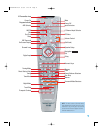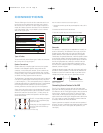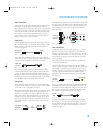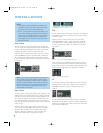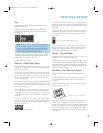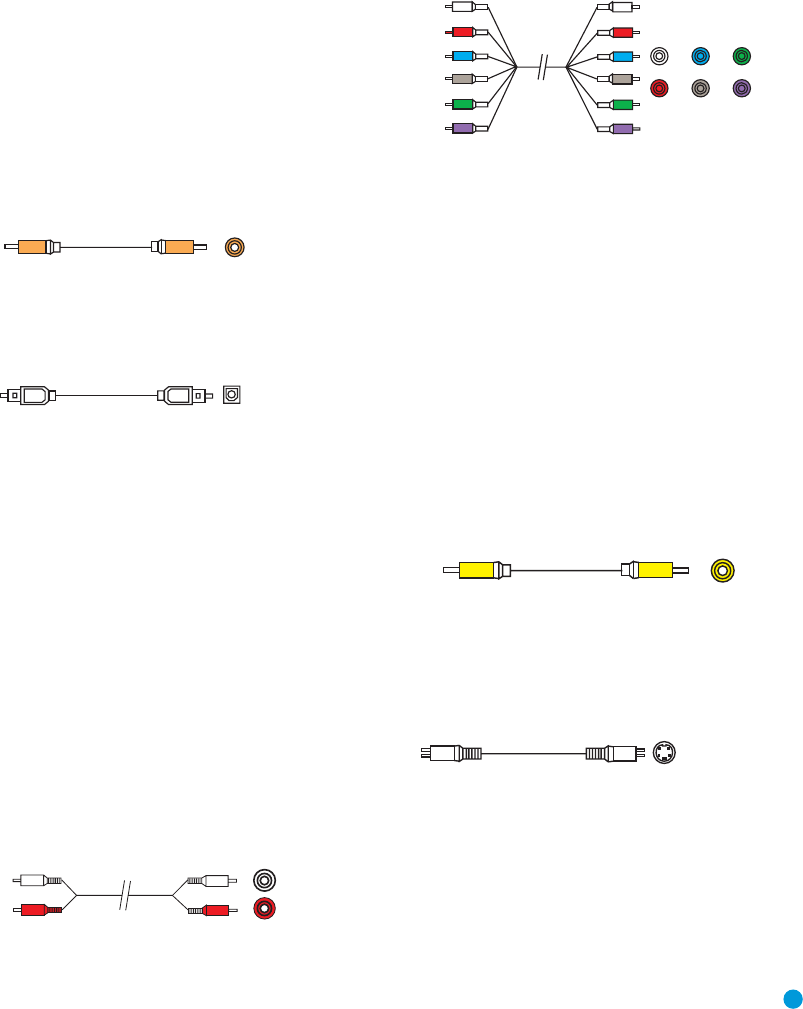
17
CONNECTIONS
Audio Connections
There are two formats for audio connections: digital and analog. Digital
audio signals are of higher quality, and are required for listening to
sources encoded with digital surround modes, such as Dolby Digital and
DTS. There are two types of digital audio connections commonly used:
coaxial and optical. Either type of digital audio connection may be used
for each source device, but never both simultaneously for the same
source. However, it’s okay to make both analog and digital audio con-
nections at the same time, to the same source.
Digital Audio
Coaxial digital audio jacks are usually color-coded in orange. Although
they look similar to analog jacks, they should not be confused, and you
should not connect coaxial digital audio outputs to analog inputs or
vice versa. See Figure 4.
Figure 4 – Coaxial Digital Audio
Optical digital audio connectors are normally covered by a shutter to
protect them from dust. The shutter opens as the cable is inserted.Input
connectors are color-coded using a black shutter. See Figure 5.
Figure 5 – Optical Digital Audio
Due to the nature of digital signals as binary bits, they aren’t subject
to signal degradation the way analog signals are.Therefore, the quality
of coaxial and optical digital audio connections should be the same,
although it is important to limit the length of the cable.Whichever type of
connection you choose, Harman Kardon recommends that you always
select the highest quality cables available within your budget.
Analog Audio
Analog connections require two cables, one for the left channel (white)
and one for the right channel (red). These two cables are often attached
to each other for most of their length. See Figure 6.
Most sources that have digital audio jacks also have analog audio jacks,
although some older types of sources, such as tape decks, have only
analog jacks. For sources that are capable of both digital and analog
audio, you may wish to make both connections. If you wish to record
materials from DVDs or other copy-protected sources, you will only be
able to do so using analog connections. Remember to comply with all
laws regarding copyright, if you choose to make a copy for your own
personal use.
Figure 6 – Analog Audio
Multichannel analog connections are used with advanced sources where
the digital content is copy-protected and all surround processing is per-
formed inside the source. These types of connections are usually used
with DVD-Audio, SACD, Blu-ray Disc, HD-DVD and other advanced
players. See Figure 7.
Figure 7 – Multichannel Analog Audio
Video Connections
Although some sources produce an audio signal only (e.g., CD player,
tape deck), many sources output both audio and video signals (e.g.,
DVD player, cable television box, HDTV tuner, satellite box, VCR, DVR).
In addition to the audio connection, you will need to connect one type of
video connection for each source (never more than one at the same
time for any source).
There are three types of analog video connections: composite video,
S-video and component video.
Composite video is the basic connection most commonly available.
The jack is usually color-coded in yellow, and looks like an analog audio
jack, although it is important never to confuse the two. Do not plug a
composite video cable into an analog or coaxial digital audio jack, and
vice versa. Both the chrominance (color) and luminance (intensity)
components of the video signal are transmitted using a single cable.
See Figure 8.
Figure 8 – Composite Video
S-video, or “separate” video, transmits the chrominance and luminance
components using separate wires contained within a single cable.The
plug on an S-video cable contains four metal pins, plus a plastic guide
pin. Be careful to line up the plug correctly when you insert it into the
jack on the receiver, source or video display. See Figure 9.
Figure 9 – S-Video
Component video separates the video signal into three components –
one luminance (“Y”) and two subsampled color signals (“Pb” and “Pr”) –
that are transmitted using three separate cables.The “Y” cable is color-
coded green, the “Pb” cable is colored blue and the “Pr” cable is col-
ored red. See Figure 10.
S-video
cable
Composite
video cable
Composite video
Multichannel
analog audio
cable (RCA)
Front Surround Center
Subwoofer
L
R
A
nalog audio
cable (RCA)
Optical
Optical digital
audio cable
Coaxial
Coaxial digital
audio cable
HKP1482AVR144-om 9/7/06 3:11 PM Page 17







